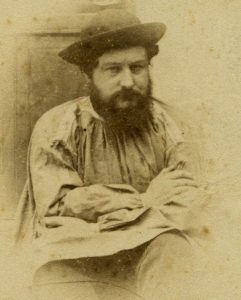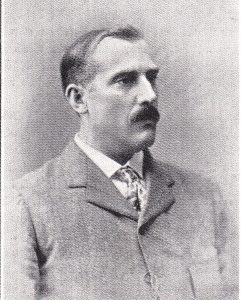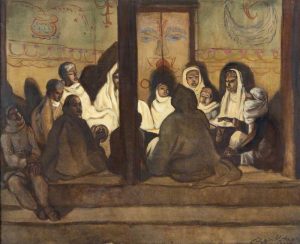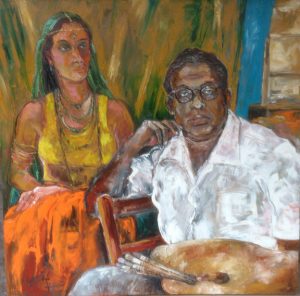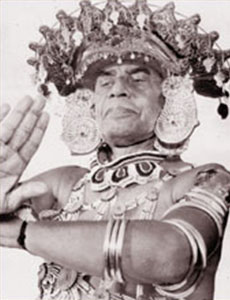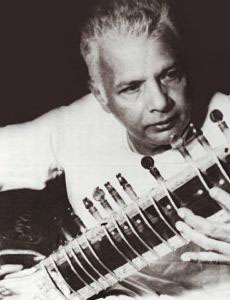BRIEF HISTORY OF UNIVERSITY OF THE VISUAL AND PERFORMING ARTS
Sri Lanka is an island nation with a distinctive history of painting and sculpture that dates back to the 3rd century BC. Historically, painting and sculpture education and practices in Sri Lanka were grounded in the Buddhist philosophy and related rituals. Artistic skills were sustained and taught by specific schools or families known as “Gurukula” or ”Siththara Parampara”. Moreover, skilled craftsmen belonged to a particular caste based on their craftsmanship duties during this era.
The naturalistic painting style of the West was first introduced to Sri Lanka and India during the British colonial period through technical colleges. With the establishment of the Ceylon Technical College in Maradana in 1893, awareness and the use of western painting techniques and styles gradually became popular in the country. Under colonial education, naturalistic painting was also introduced to Sri Lanka. Dr. Ananda Kentish Coomaraswamy (1877-1947), a pioneering Sri Lankan philosopher and interpreter of Indian art and culture, published his first book in 1908, named ‘Medieval Sinhalese Art’ which focused on Sri Lankan crafts and its craft schools. The book was printed by the Kelmscott Press in London which was owned by William Morris (1834-1896), the founder of the ‘Art and Craft movement’ in England. Hence, in 1896 (the same year he passed away), as a tribute to the contribution made by William Morris, craft subjects were introduced into the courses of study offered at the Ceylon Technical College. These subjects were later conducted in collaboration with the Department of Small Industries in 1933.
Alfred Bartlam (1858 – 1937), a scholar of the Royal College of Art and the Art and Science Department in London, is recorded as the first person to be appointed by the United Kingdom to Sri Lanka to commence local art education. After being recruited by the Colonial Office in London in May 1900, Bartlam began his career as the first drawing instructor of the Ceylon Technical College in Maradana in 1902. He was also a technological certificate holder from the City and Guilds of the London Institute. Apart from teaching at the Technical College, he later served as the secretary of the Ceylon Society of Arts . However, British Painter Charles Freegrove Winzer (1886 – 1940) is considered as the pioneer and patron of modern art in Sri Lanka. In 920, he was appointed as the Chief Art Inspector of the Department of Education in Sri Lanka. Henceforth, he served in this position for 11 years until 1932. Winzer was equipped with a profound knowledge, interest and understanding of various trends in the field of painting. He was responsible in identifying and promoting Sri Lankan born artists J.D.A. Perera (1897-1967) and W.J.G. Beling (1967-1992) who became the local forerunners of tertiary and secondary level art education in Sri Lanka. These two individuals are considered as the most suitable and brilliant choices made by C.F. Winzer who was incidentally the founder of the Modern Art Movement that he led and known as the ‘43 Group’ ( viable artistic brotherhood from 1943-1964) in Sri Lanka.
With these developments, the Arts and Crafts Department of the Ceylon Technical College grew rapidly owing to the employment avenues opened to the art students and their teachers both in the arts and crafts schools as well as in the craft centres. In the year 1943, for example, the Department produced 30 teachers in arts and crafts. In 1946, a Board of Moderators was appointed to design syllabi and to attend various related matters in eight different craft courses. After the Second World War in 1949 the Department of Arts and Crafts of the Ceylon Technical College was shifted to the Heywood building situated at Horton Place, Colombo 07, under the supervision of the painter J.D.A. Perera. This is where the Faculty of Visual Arts of the University of the Visual and Performing Arts (UVPA) is located at present. The Department of Arts and Crafts of the Ceylon Technical College was separated from the Ceylon Technical College in 1952, and it was upgraded as the ‘Government Institute of Arts’. Subsequently, traditional dance and North Indian music courses were introduced according to the vision of the then Head of the Institute, -J.D.A. Perera. Until then, traditional Sri Lankan dance forms had been practiced under the “Gurukula” and “Kalayathana” education system. Since Sri Lankan traditional music genres had not been identified as scholarly during this time, North Indian music was introduced to the Institute instead. Panibharatha (1920-2005) and Lionel Edirisinghe (1913-1988) were appointed as course masters for the dance and music programmes respectively.
In 1953, the Government Institute of Arts was renamed as the Government School of Fine Arts whereby it became an independent Department under the Ministry of Education. It provided teaching facilities for drawing, painting, sculpture, crafts, music and dance courses. All disciplines – painting, sculpture, craft, music and dance – were taught at the Horton Place premises. However, the music and dance courses were subsequently shifted to a new premises in Albert Crescent, Colombo 07, due to the lack of space. J.D.A. Perera was the first principal of the Government School of Fine Arts. Painter David Paynter was the second principal (1900-1975) of the school; he was succeeded by veteran painter Stanly Abeysinghe (1914-1994). At the beginning, the medium of instruction for all visual arts subjects at the Government College of Fine Arts was English. Its founder, J.D.A. Perera, commenced a Department of Sinhala in 1952 to conduct art courses in Sinhala medium. He recruited local art teachers and artisans as lecturers for this purpose. In 1960, the Government College of Fine Arts was again renamed as the ‘Sri Lanka National Institute of Arts’ under the Ministry of Cultural Affairs. Five years later, the arts and crafts section at the Horton Place, Colombo 7, was upgraded as an independent college, named as the Government College of Arts and Crafts under the Ministry of Education. Stanley Abeysinghe was appointed as the Principal of the Government College of Arts and Crafts. Consequently, the music section was upgraded and renamed as the ‘Government College of Music’ and veteran musician Lionel Edirisinghe (1913-1988) was appointed as its Principal. The dance section was also upgraded whereby it became to know as the ‘Government College of Dance and Ballet’. Veteran dancer S. Panibharatha (1920-2006) was appointed as the Principal.
Lionel Edirisinghe
In 1973, two experts, Prof. H.G. Hanmante, Dean, Sir JJ Institute of Applied Arts, Mumbai and Prof. Palsikar, Dean, Sir JJ School of Fine Arts, Mumbai were invited by the Government of Sri Lanka under the ‘Colombo Plan’ to restructure the Government College of Arts and Crafts. However, no experts were consulted or invited to restructure the Government College of Music and the Government College of Dance and Ballet. Based on the report by these two Indian experts, the ‘Institute of Aesthetic Studies’ (IAS) was created in 1974 by amalgamating the Government College of Arts and Crafts, the Government College of Music, the Government College of Dance and Ballet and the Ramanathan Academy in Jaffna. The IAS consisted of three departments; namely, the Department of Art and Sculpture, the Department of Music, and the Department of Dance and Ballet. F Mahagama Sekara, considered to be a significant figure in Sinhalese poetry and literature, was appointed as the first Head of the Department of Art and Sculpture, while veteran musician W.D. Amaradeva was appointed the first Head of the Department of Music. Panibharatha was appointed the first Head of the Department of Dance and Ballet. The First Director of the IAS was Dr. Hema Rathnayake, a historian from the University of Colombo. The IAS became affiliated to the University of Kelaniya in 1980. Meanwhile, the Ramanathan Academy was separated from the IAS and it was affiliated to the University of Jaffna. In the same year the ‘Sripali Kalayathanaya’ in Horana, an institute for aesthetic subjects, was absorbed into the IAS. In 1993, however, the ‘Sripali Kalayathanaya’, was affiliated to the University of Colombo. During a span of 30 years, from 1974 to 2004, twenty-nine Directors were appointed to the IAS . The last Director of the IAS, was Keerthirathne Herath, an officer of the Sri Lanka Administrative Service. A special committee was appointed to the Institute of Aesthetic Studies (IAS) to investigate its education and the structural system. The committee comprised of three members; Prof. Senaka Bandaranayake, Prof. Tissa Kariyawasam and Prof. Walter Marasinghe. On the recommendation of their report, it was declared by the Extraordinary Gazette notification of the Democratic Socialist Republic of Sri Lanka number 1400/24 08.07.2005 that the IAS was granted university status whereby it was reestablished as the University of the Visual and Performing Arts (UVPA) with effect from 1 July 2005 under the Universities Act No. 16 of 1978 for the purpose of “providing, promoting and developing higher education in the branches of the learning of Visual and Performing Arts and for advancing these arts to achieve standards of excellence in relation to their aesthetic and applied dimensions”.
Prof. Sarath Amunugama was appointed the first Vice-Chancellor of the University. A French language scholar from the University of Kelaniya, he introduced the university system to the newly established UVPA. Prof. Jayasena Kottegoda, a veteran Low-country traditional dance scholar, was appointed in 2008 as the second Vice Chancellor of the University whereby he served two consecutive terms in office. Subsequently, yet another expert in Low-country traditional dance, Prof. Ariyarathna Kaluarachchi assumed duties as the University’s Vice-Chancellor in 2014. After his term of 3 years, Prof. Sarath Chandrajeewa became the fourth Vice-Chancellor of the UVPA from October 2017. At present, the Vice-Chancellor of the University is Snr. Prof. Rohana P. Mahaliyanaarachchi. He who was a former Vice-Chancellor of the Sabaragamuwa University of Sri Lnka.
The first Chancellor of the University of the Visual and Performing Arts was Dr. Lester James Peiris, while Pandith Dr. W.D. Amaradeva became its second Chancellor. At present, the Chancellor of the UVPA is Sangeeth Nipun Prof. Sanath Nandasiri.
